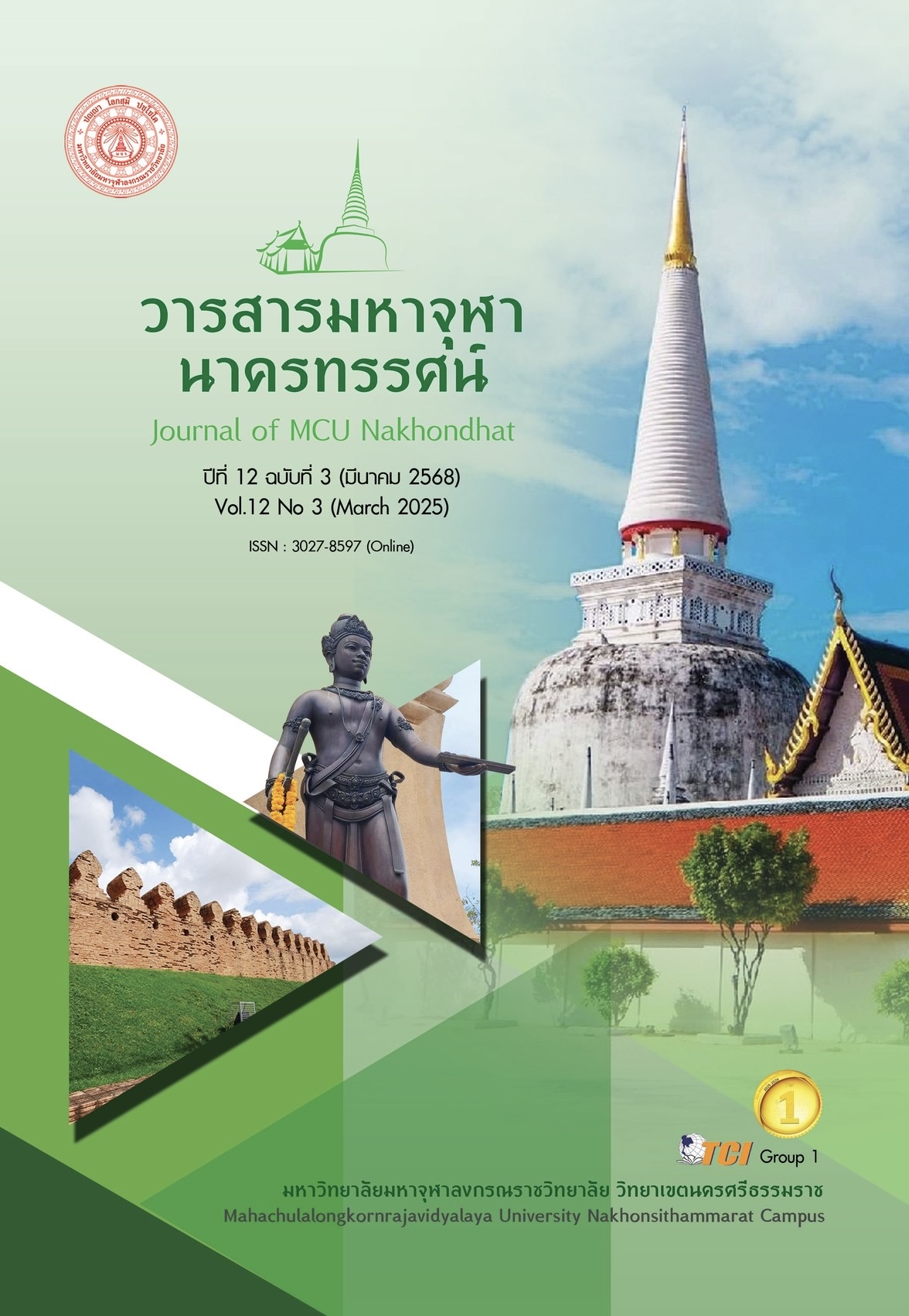A PROPOSED CURRICULUM TO PROMOTE THE QUALITY OF LIFE OF THE ELDERLY BASED ON ROY’S ADAPTATION: AN INTEGRATION OF THAI FOLK DANCE AS DANCE THERAPY IN AN ELDERLY SCHOOL
Main Article Content
Abstract
The research objectives were to study the elderly’s problems and needs in enhancing their quality of life and to examine the learning management approach aimed at developing and evaluating a curriculum for elderly schools. This curriculum is intended to promote the elderly’s quality of life based on Roy’s Adaptation Model and incorporates the application of folk dance, designed according to dance therapy theories. The research was conducted in two steps following the Research and Development process (R&D). In Step 1, the research engaged a sample group of 15 elderly participants aged 60 or above. In Step 2, the study included 10 elderly participants from an elderly school. Research instruments comprised interviews, assessments of the curriculum, and evaluations of document appropriateness. Data were collected through in-depth interviews and analyzed using descriptive methods. The findings indicated that elderly individuals faced challenges related to quality of life and exhibited mild health issues such as cholesterol, blood pressure, tyrosine levels, and diabetes. Additionally, they were found to engage in less exercise and experienced difficulties in resting and sleeping. Moreover, they were more sensitive and became easily saddened by minor incidents. In terms of socialization, their participation in social activities was reduced, and environmentally, their residences lacked sufficient conveniences for their daily living, with inadequate knowledge about creating environments suitable for the elderly. Consequently, there is a need to promote an enhanced quality of life, both mentally and physically. In developing an approach to improve quality of life, promoting physical well-being should be emphasized. During the development and evaluation of the curriculum, seven features were examined: Background and rationale, principles, objectives, structures, activity management, application of materials and learning sources, and evaluation methods. The development and quality of the curriculum attained the highest level of appropriateness. The developed curriculum was suitable for application and utilization.
Article Details

This work is licensed under a Creative Commons Attribution-NonCommercial-NoDerivatives 4.0 International License.
References
กรมกิจการผู้สูงอายุ. (2560). คู่มือโรงเรียนผู้สูงอายุ. กรุงเทพมหานคร: กองส่งเสริมศักยภาพผู้สูงอายุ.
กฤษณพันธ์ เพ็งศรี. (2565). รูปแบบการจัดกิจกรรมการเรียนรู้แบบมีส่วนร่วมสําหรับผู้สูงอายุ. วารสารวิจัยทาง การศึกษาคณะศึกษาศาสตร์ มหาวิทยาลัยศรีนครินทรวิโรฒ, 7(2), 1-10.
กองสุขศึกษา กระทรวงสาธารณะสุข. (2564). คู่มือการจัดกิจกรรมเสริมสร้างความรอบรู้ด้านสุขภาพในกลุ่มผู้สูงอายุสำหรับเจ้าหน้าที่และผู้ดูแล. (พิมพ์ครั้งที่ 1). กรุงเทพมหานคร: บริษัท นิวธรรมดาการพิมพ์ (ประเทศไทย) จำกัด.
กัญญาวีร์ เปี้ยนสีทอง และคณะ. (2561). การบริหารกล้ามเนื้อในผู้สูงอายุโดยใช้กิจกรรมนาฏศิลป์บำบัดสำหรับชุมชนไทยพวน จังหวัดนครนายก. วารสารวิชาการนวัตกรรมสื่อสารสังคม มหาวิทยาลัยศรีนครินทรวิโรฒ, 6(1), 126-136.
กัตติกา ธนะขว้าง และจินตนา รัตนวิฑูรย์. (2556). ผลของการรำไม้พลองมองเซิงเมืองน่านต่อสมรรถภาพทางกายและคุณภาพชีวิตด้านสุขภาพของผู้สูงอายุหญิงที่ไม่ได้ออกกำลังกายเป็นประจำ. พยาบาลสาร, 40(2), 148-161.
จินดา อุ่นทอง. (2565). การพัฒนาหลักสูตรเสริมสร้างความสามารถการวิจัยในชั้นเรียนของครูการศึกษาพิเศษ โดยใช้การพัฒนาบทเรียนร่วมกันกับทีมสหวิชาชีพ. ใน ดุษฎีนิพนธ์การศึกษาดุษฎีบัณฑิต สาขาวิชาหลักสูตรและการสอน. มหาวิทยาลัยนเรศวร.
ชญาภัสร์ สมกระโทก และคณะ. (2565). หลักสูตรฝึกอบรมเพื่อเสริมสร้างความสามารถในการออกแบบการจัด การเรียนรู้เรื่องความปลอดภัยในชีวิตของครูสุขศึกษา. วารสารวิชาการมหาวิทยาลัยการกีฬาแห่งชาติ, 14(2), 171-187.
ทวีศักดิ์ สิริรัตน์เรขา. (2550). การบำบัดทางเลือกในเด็กพิเศษ. (พิมพ์ครั้งที่ 16). กรุงเทพมหานคร: โรงพิมพ์คุรุสภาลาดพร้าว.
ปรานี วงษ์เทศ. (2525). พื้นบ้านพื้นเมือง. กรุงเทพมหานคร: เรือนแก้วการพิมพ์.
ศศิธร พุมดวง. (2548). ดนตรีบำบัด. สงขลานครินทร์เวชสาร, 23(3), 185-191.
สำนักงานสภาพัฒนาการเศรษฐกิจและสังคมแห่งชาติ. (2562). รายงานการศึกษาผลกระทบจากการเปลี่ยนแปลงโครงสร้างประชากร และข้อเสนอแนะเชิงนโยบายต่อการพัฒนาประเทศ จากผลการคาดประมาณประชากรของประเทศไทย. (พิมพ์ครั้งที่ 1). กรุงเทพมหานคร: อมรินทร์พริ้นติ้งแอนด์พับลิชชิ่ง.
อังคณา อ่อนธานี. (2564). ผลการใช้การจัดการเรียนรู้แบบมีส่วนร่วมเพื่อส่งเสริมสมรรถนะการทำงานและอาชีพสำหรับนักเรียนระดับมัธยมศึกษา. วารสารศึกษาศาสตร์ มหาวิทยาลัยนเรศวร, 23(2), 336-350.
Cohen, L. et al. (2018). Research Methods in Education. (8th ed.). London: Routledge.
Dixon, E. L. (2002). Community Health Nursing Practice and the Roy Adaptation Model. Public Health Nurs, 16(4), 290-300.
Fawcett, J. (2009). Using the Roy Adaptation Model to Guide Research and/or Practice: Construction of Conceptual-Theoretical-Empirical Systems of Knowledge. AQUICHAN, 9(3), 297-306.
Hertzog M. A. (2008). Considerations in determining sample size for pilot studies. Research in nursing & health, 31(2), 180-191.
Kranthi, K. (2017). Technology enhanced language learning (TELL). International Journal of Business and Management Invention, 6(2), 30-33.
Penny, L. B. (1972). Theory and Methods in Dance-Movement Therapy: A Manual for Therapists, Students, and Educators. Iowa: Kendall/Hunt Publishing Company.
Peter, F. O. (2001). Developing the curriculum. (5th ed.). New York: Longman.
Roy, S. C. (1999). The Roy adaptation model: The definitive statement. New York City: Appleton & Lange.
Saeed, H. & Ali, H. D. (2010). The effect of an exercise program on the health-quality of life in older adults. A randomized controlled trial. Dan Med Bull, 57(1), A4113.
Taba, H. (1962). Curriculum development: Theory and practice. New York: Harcourt, Brace & World.
Wang, H. (2019). The Effectiveness of Dance Movement Therapy with Elderly Women Who Have Dementia. Retrieved January 14, 2025, from https://digitalcommons.lesley.edu/cgi/viewcontent.cgi?article=1234&context=expressive_theses.

